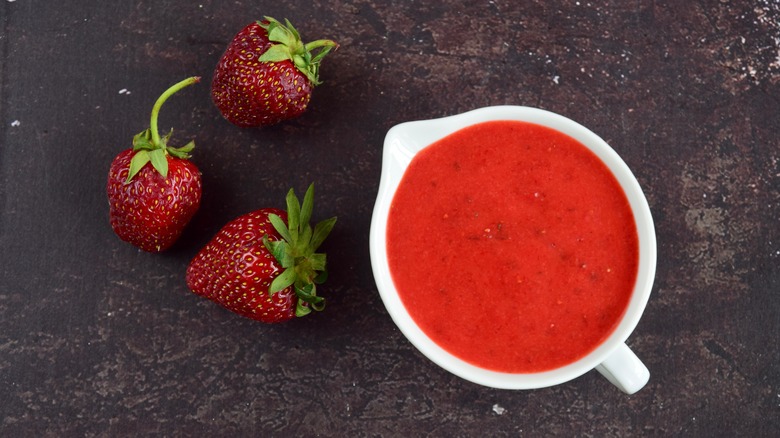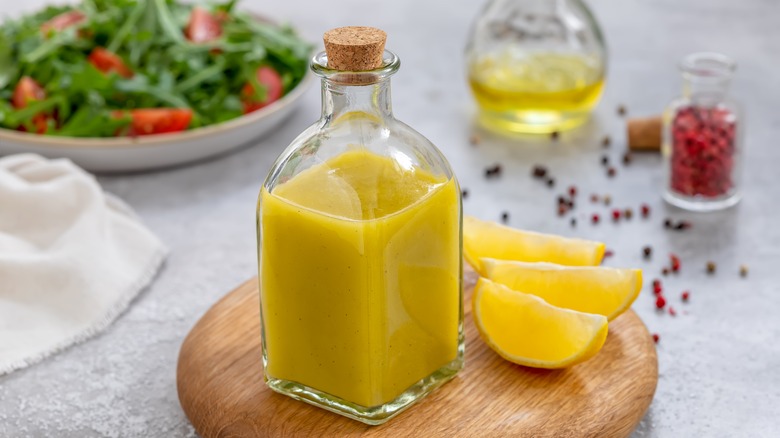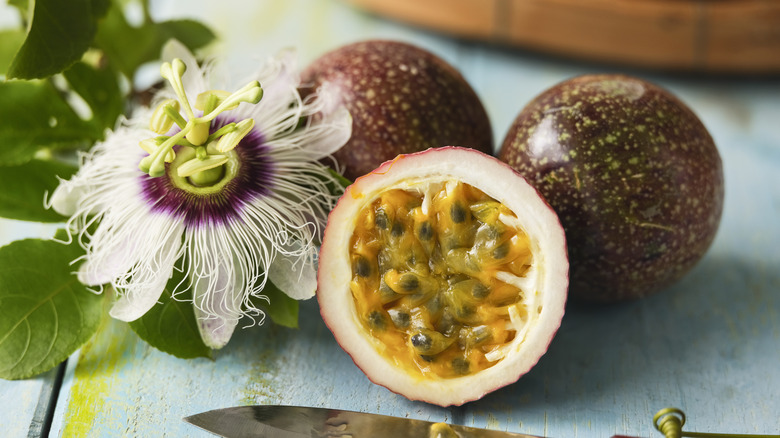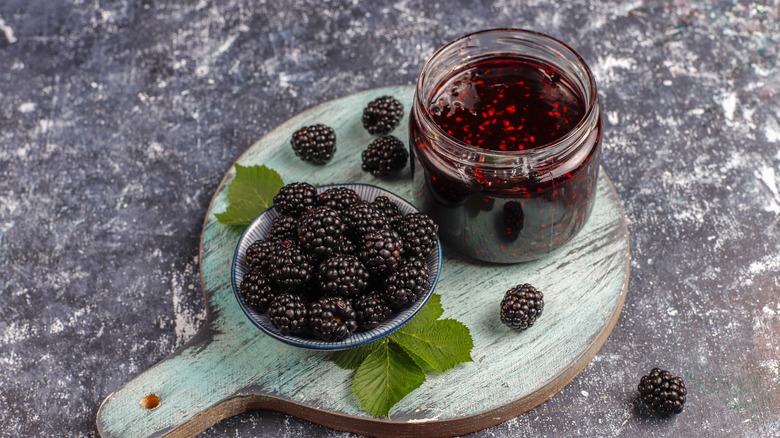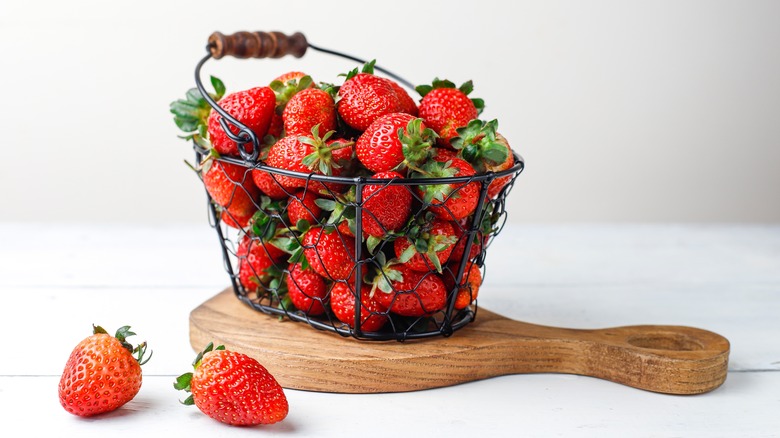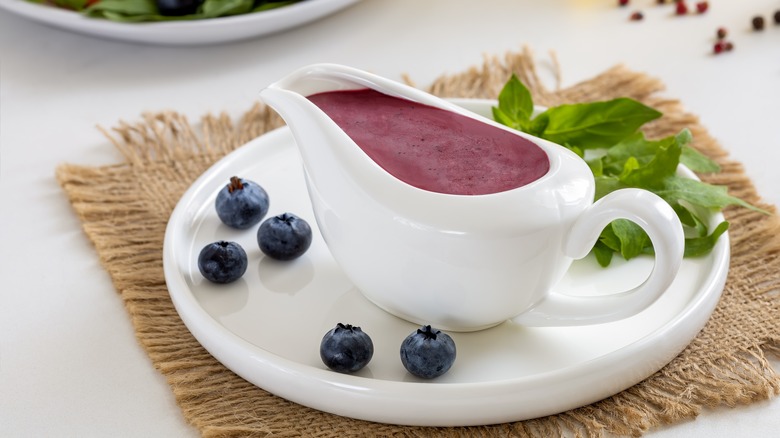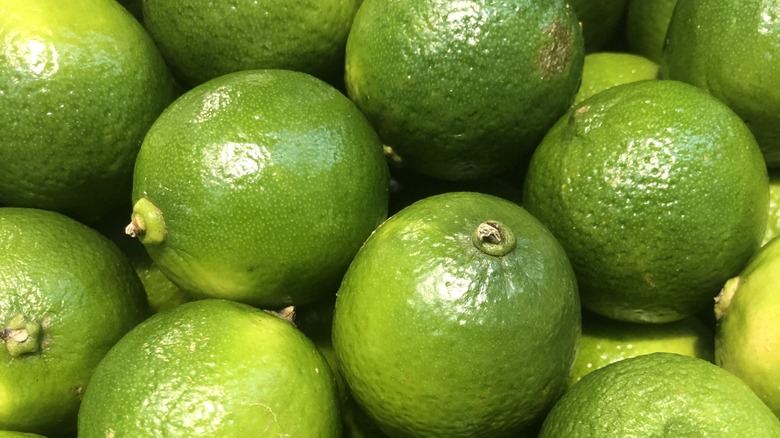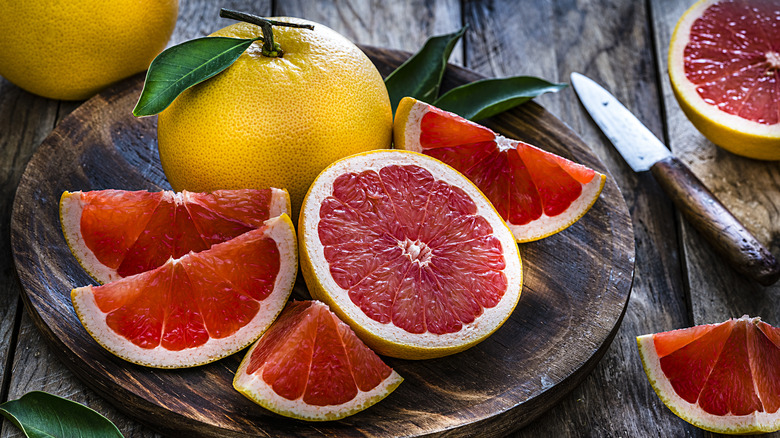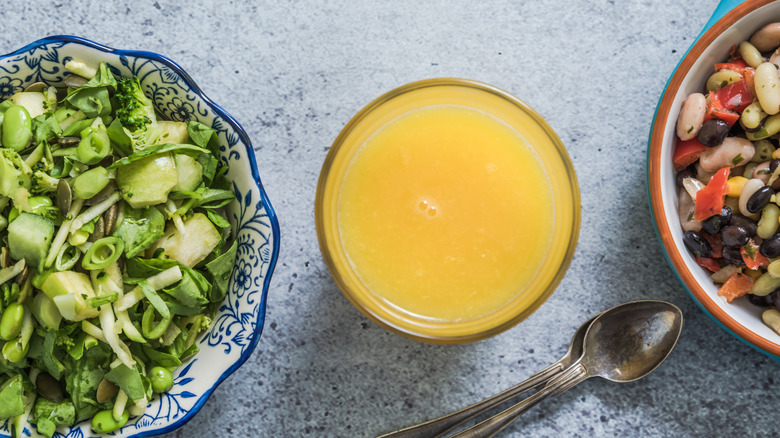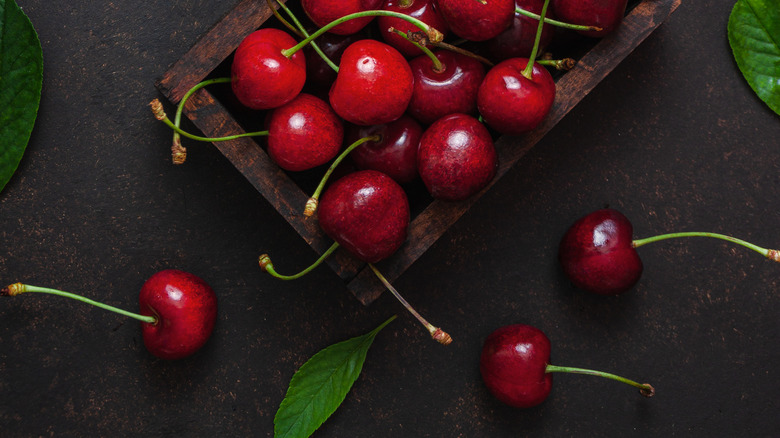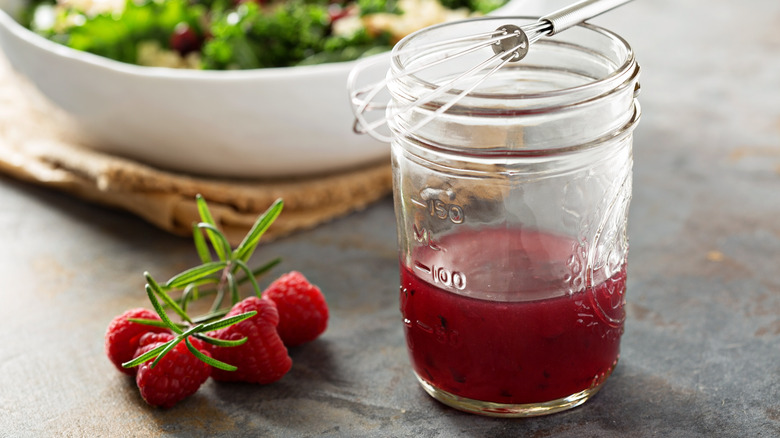The 10 Best Fruits To Blend Into A Vinaigrette
Although fruit might seem like a seasonal food, abundant in the warmer months and forgotten when the snow falls, it deserves a spot at the table all year-round. The options are endless when it comes to fruit. You can choose from hundreds of varieties, shapes, colors, and sizes. The flavors range from sour and tangy, to sweet and subtle. There is something out there for everyone, and luckily, fruit is loaded with natural vitamins, antioxidants, and fiber to help keep your health in tip-top shape, per Nutrition Facts. So, why not include it in dressings?
For those who enjoy salads, squeezing in your daily fruits and vegetables likely isn't a problem. But if your salads consistently contain ingredients like iceberg lettuce, cherry tomatoes, and pre-shredded carrots, it's time to expand your horizons and learn to build a salad that will leave your meat-and-potato-loving friends drooling.
It's all about the dressing, baby, so it's important to learn how to make a well-balanced vinaigrette, and adding fresh fruit is a game-changer. Fruit can help bring both a citrus and sweet element to any salad dressing, but the key is to choose your variety wisely and pair it properly with your anterior salad ingredients. But not all fruits are created equal when it comes to dressing; below, a compilation of the best fruits to blend into a vinaigrette.
Lemon
When it comes to fruits commonly found in vinaigrettes, lemon takes the cake. This is because, for a balanced vinaigrette, you need acidic components. Reflective of its name, vinegar is the acid of choice when it comes to vinaigrettes. Fruit acids, like the ones found in citrus, are also welcomed into the formula. Although there are different varieties of lemons with varying flavors, they are typically tart, sour, bitter, and intense, with a sweet and refreshing undertone. Because of their concentrated flavor, it doesn't take much to make a statement.
For a lemon vinaigrette, choose a light vinegar to complement the fruit; white balsamic, champagne vinegar, or white wine vinegar will do the trick. You can even use alternative vinegar like pickle brine to make a preserved lemon vinaigrette. For any homemade recipe, use less vinegar than you typically would when adding lemon, because its natural flavor will act as an acid to elevate that overall tanginess. Balance the intensity of the lemon and vinegar with natural sweeteners like honey, and don't skimp on the freshly minced herbs and aromatic spices.
Use a lemon vinaigrette to top a light, crisp salad like one with fresh fruits, cheeses, white meats, and seafood. Don't forget that lemon is quite diverse and can also accompany robust dark leafy greens, beans, nuts, meats, and roasted mushrooms. For extra pizzaz, add lemon zest to the vinaigrette, or use it to top a salad.
Passionfruit
Tropical fruits are often overlooked when it comes to those ideal for vinaigrette, but they have potential. Certain varieties uncommon in the U.S., or at least in the northern regions, are worth the purchase if you can get your hands on them. Passionfruit is one of those unique, flavorful tropical fruits that is not only delicious but also beautiful. Although passionfruit has a deep pink exterior, the fleshy edible part consisting mostly of edible black seeds is bright yellow. It's very pulpy and has a pronounced sweetness with tart undertones.
Because the fruit is so seedy, you could either opt to separate the flesh from the seeds or leave the seeds intact. Consider leaving them whole and including them, as they can add an aesthetic appeal to your dressing or a pleasing crunch to your salad. Use light vinegar, along with lime juice and honey for balance. Add honey sparingly, as you may find the fruit itself is sweet enough. Drizzle in extra virgin olive oil and whisk it all together before lightly dressing your delicate greens.
Passionfruit pairs well with crisp, refreshing flavors like cucumber, radish, and celery. If you choose to include cheese, stick to something soft, mild, and tangy like goat cheese. When it comes to adding proteins, choose seafood or tofu, then lean into the colorful aesthetic by including bright, eye-catching ingredients like starfruit, diced orange pepper, and pickled beets.
Blackberry
Commonly found in the United States are blackberries, crunchy beauties that might even be growing wild in your backyard or alongside your favorite hiking trail. They are very juicy, dark in color, and slightly tart and ,unbeknownst to many, blackberries are quite different than black raspberries, which are sweeter and often smaller.
A blackberry's deep purple-blue coloring is quite striking, and will greatly affect the aesthetic of your vinaigrette. Because blackberries contain so many little seeds, they are slightly crunchy in texture, which can be quite pleasant in adding a variety of mouthfeel to your salad. It's typically a good idea to mash the berries with a mortar and pestle, or put them in a blender, instead of juicing them to add to a vinaigrette.
Although many fruits taste best when paired with a light refreshing flavor, blackberries have more range. Consider using dark balsamic vinegar to highlight the berry's depth, but also know that you can use citrus and balsamic to lighten it up. If you go the dark balsamic route, sweeten your dressing with maple syrup, and pour it over dark leafy greens. Use fall-time toppings like pecans, roasted squash or Brussels sprouts, and thinly sliced grilled red meats. Both soft and hard cheese can help balance and highlight the tangy intensity of blackberries. Other mellow fruits like pears can complement the fruit's natural sweetness, without stealing the show from your statement vinaigrette.
Strawberry
You may have tried a strawberry vinaigrette before, but the homemade version is quite different than anything you'll find pre-bottled at the grocery store. These versions are often quite syrupy, and sticky-sweet, while making such a dressing from scratch gives you flexibility in flavor and texture. Strawberries carry a range of flavors, from mellow and tart to juicy and overwhelmingly sweet, depending on the variety. Some describe strawberries as having floral undertones, while others compare them to apples and pineapples, but all are delicious.
Start by deciding if you'd prefer to use freshly blended strawberries — which will result in a thicker, and crunchier vinaigrette as a result of the seeds — or if you'd rather juice the berries and create a strawberry reduction. The reduction will be darker, thicker, and sweeter than the blended berries, so it's entirely up to the cook. Either way, pair your strawberry juice or blend with a sweet vinegar like apple cider vinegar, along with olive oil, dijon mustard, and a rich sweetener like honey.
Enjoy your vinaigrette in a light spinach summer salad, or over spicy greens like arugula. Light cheeses, toasted nuts, and colorful vegetables complement the fruit delightfully. Enjoy it over a standard strawberry arugula salad recipe, because what goes better with strawberries than strawberries?
Blueberry
If you've ever spent time in Maine, you know blueberries can be incorporated into pretty much any dish. Although blueberries make an appearance in salads all over the United States, the state of Maine does a particularly good job at going the extra mile and using their extra small, extra powerful berries in just about everything, including vinaigrettes. Any variety of blueberries, however, can make for a colorful, flavorful salad dressing. Although blueberries are dark blue on the outside, they become purple when mashed, and like most berries, they have a delicate seedy crunch to them; if you enjoy that texture, be sure to blend or mash the berries instead of juicing them.
Blended, juiced, or juiced and reduced blueberries pair well with a dark sweet balsamic vinegar. In addition, include some lemon, as lemon and blueberries pair well together. Blueberry salads often contain goat cheeses, fresh mozzarella, or feta cheese, as these refreshing flavors can help balance the sweetness of blueberries and balsamic. In addition, the bright purple vinaigrette will dye the cheese, giving it a uniquely appealing appearance. Sliced raw or toasted almonds can add earthy and woody undertones that contrast the tart juicy berries in a pleasing way. Choose dark leafy greens like kale, which can be massaged with olive oil to make it less bitter and more tender.
Lime
Like lemon, lime juice acts alongside vinegar as a tart, acidic component to a vinaigrette. There are major differences in flavor between key limes and the basic limes that you might find at the grocery store. Key limes are identifiable as smaller, notably tarter, and more floral. They also tend to be very aromatic, which is why they make for such an incredible ingredient in key lime pie. Both your standard lime or key limes can be used in a vinaigrette, as long as you understand the differences.
Use the juice as the main acidic component, but feel free to add white balsamic or light vinegar as well. Sweeten with honey, and use Dijon mustard and extra virgin olive oil. This basic formula works wonders with lime juice, but note that you can also create your own flavor profile using spices and herbs like cilantro or lemongrass. Enhance the fruit's flavor by using lime zest, and mix it right into the vinaigrette. Enjoy this dressing over fruit salad, or a vegetable salad featuring light, crisp greens. Include both fruits and vegetables like cucumber, mango, red onion, and bell peppers. Sweet and floral produce can help to complement the tanginess of the lime juice.
Grapefruit
Although grapefruits seem to make their way into plenty of beauty products like lotions and soaps, it's less common to see them used in everyday cooking, especially savory dishes. But just like lemons and limes, grapefruits are tart, tangy, juicy, and sweet, so why not?
Some folks find them to be bitter, while others can't get enough of them raw, right out of the peel with a grapefruit spoon. Red grapefruit is the sweetest of all the varieties, with a mellower tartness, and louder notes of sweetness. Each variety delivers a slightly different level of intensity, but when it comes to vinaigrette, the tangier the better.
Pair your juiced grapefruit with white balsamic vinegar, or red wine vinegar. Use aromatics like shallots that have a sweetness to them, along with honey, dijon mustard, and extra virgin olive oil. Citrus fruits tend to pair well with this basic vinaigrette formula, but feel free to stray from classic flavors with fresh basil, black pepper, or even rosemary. Enjoy your pink vinaigrette over a salad with sharp complementary flavors like endives and goat cheese. Use chunks of fresh or grilled grapefruit to add color and enhance the citrus fruit's profile.
Avocado can help to mellow out the bitterness, along with other mild ingredients like butter lettuce and pine nuts. Keep in mind that grapefruit can dull the effects of some prescription medications (per the FDA), so check with your doctor before indulging in an abundance of grapefruit juice.
Mango
Unlike citrus fruits, mangos are sweet without tanginess or bitterness. They are also smooth in texture and elegantly bright. This is why you should consider blending the whole fruit right into the vinaigrette using a high-speed blender. Use light vinegar and sweet vinegar (like apple cider vinegar or sherry vinegar), along with robust olive oil, honey, and black pepper. Because mango is so sweet, it sometimes benefits from a spicy undertone, which you can accomplish by adding red pepper flakes or cayenne. Stand aside hot honey, cayenne mango is the next great sweet heat combination.
Because mango vinaigrette is so powerful and unique, it holds up well with intense cheeses like blue cheese or gorgonzola, but of course, also dresses up soft goat cheese beautifully. Lean into the tropical nature of the dressing by including light and tropical ingredients like avocado and chunks of mango. In addition, cucumber, red pepper, butter lettuce, and spinach tend to allow the mango to shine. Give a spinach salad with mango vinaigrette a try, and load it up with chopped raw cashews and thinly sliced red onion. You can also use a tangy mango vinaigrette to dress a fruit salad, or create a sweet version omitting any aromatics or dijon and drizzle it over ice cream as a tangy, colorful dessert.
Cherry
Stone fruits have a sweet, supple, rounded flavor profile that can be intoxicating. Cherries, in particular, have such a unique dark richness to them that can take a vinaigrette to the next level.
Start by blending fresh or frozen dark cherries (mind the pits), or juicing them. Those with less time on their hands can spring for a bottle of 100% dark cherry juice, with no added sugars. For concentrated sweetness, reduce it to make a syrup. However you decide to process the cherries, next pair them with balsamic vinegar to make your vinaigrette. Include some red wine vinegar or lemon juice for a slightly tangier outcome, giving it a boost in flavor. In fact, this upgraded vinaigrette formula will take your salad to the next level, so don't skimp on the citrus or vinegar.
Whisk with crushed black pepper, maple syrup, minced garlic or shallots, and whole-grain mustard. Extra virgin olive oil can add a floral richness that complements the stone fruit well. This deep, rich vinaigrette goes well with massaged kale or spicy arugula. Load up your salad with toasted nutty flavors, berries, sweet vegetables, and cheese. Cheese and cherries pair particularly well, and bits of olives or pancetta can help add some salt to the equation. A cherry vinaigrette is intense and can hold its own alongside strong flavors, but be sure not to overwhelm the palate by keeping ingredients minimal.
Raspberry
Even if you're not entirely familiar with the world of fruit-based vinaigrettes, it's likely you've seen raspberry vinaigrette as an option on menus. It might even seem like a United States staple, but raspberry vinaigrette has French origins. Perhaps it's so popular because of the fruit's rounded sweetness, floral undertones, or textured mouthfeel. The homemade version will likely differ from the syrupy sauce you might receive at a fast-food chain or salad bar, so gear up your tastebuds for the freshest, tangiest, raspberry vinaigrette you've ever tried.
Like most berries, raspberries have a series of small, crunchy seeds, which helps add texture to salad and other dishes. Blend or mash the raspberries before you whisk them with your basic vinaigrette ingredients, including olive oil, dijon mustard, and a sweetener of choice like agave or maple syrup. Consider using white balsamic, champagne vinegar, or white wine vinegar so as not to overpower the delicate flavors of the fruit, and to help preserve its beautiful pink and red coloring. Include fresh herbs like basil, or citrus fruit like lemon juice to help enhance the flavor of the dressing. Freshly crushed black pepper complements raspberries particularly well without overpowering the vinaigrette with heat.
Drizzle your raspberry dressing over delicate greens, arugula, and spinach, or mix with radicchio lettuce, loaded with toppings like almonds, red onion, tangy cheeses, and fresh berries. You'll love the taste.
